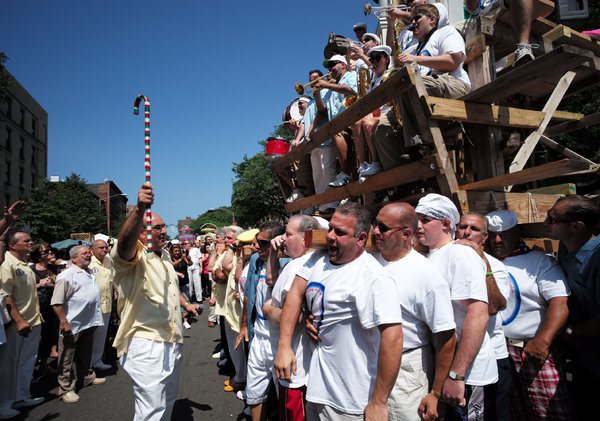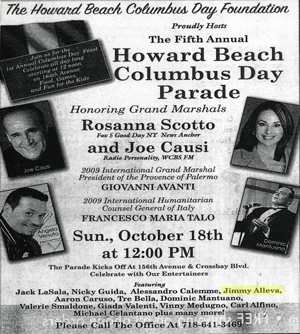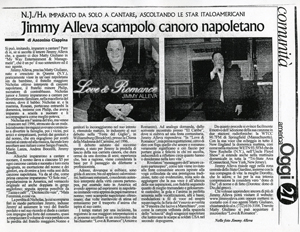
Italian-Americans have gathered in East Harlem each year since the early 1900s
to build and lift, at left, a large tower, below, in honor of St. Anthony of Padua, even after
many Italian residents moved out of the neighborhood.
Italian-Americans Return to East Harlem So
That St. Anthony's Tower Can Rise Again
Article as seen in the NY
Times - 2/11/13
By Alan Feuer:

Ozier Muhammad/The New York Times
This year's tower was 83-feet-tall
and weighed multiple tons.
Among the items raised on Sunday at a festival in East Harlem
- aside, of course, from the giglio, an 83-foot-tall wooden
tower built in honor of St. Anthony of Padua - was a question
of moral geography: Do New Yorkers actually have to live
in a neighborhood to claim it as their own?
The overwhelming answer, at least according to the members of the Giglio Society of East Harlem, was absolutely not.
"I moved out of here in 1970," said Phil Bruno, a 63-year-old
Long Islander, who has been taking part in the festival since
he was a child, "but this is still home to me. There's just
a feeling in East Harlem - for all of us. It's in your heart."
Beginning in the early 1900s, with occasional relocations
and interruptions, Italian-Americans in the neighborhood
near Pleasant Avenue and the upper East 100s have engaged
each August in the ritual of building and lifting the giglio
- or "lily" in Italian - a latticed shrine to their patron
saint made of wood and papier-mache' and strewed with colorful
flowers. The tradition dates to A.D. 409 in the village of
Nola, Italy, which is not far from the town of Brusciano,
itself outside of Naples, where many of the society's members
trace their heritage.
The Pleasant Avenue area was once one of New York's largest
Italian neighborhoods, though over the years, it has become
largely Hispanic. Italianate traces can still be found, although
not that many. There is Claudio's barbershop on East 116th
Street and a few remaining restaurants like Rao's, the famously
exclusive trattoria.
But for one weekend every summer, the zeppoles and Neapolitan folk songs return.
"We prepare for this all year," said Karen Prisco, 68, who
grew up in East Harlem but now lives in Toms River, N.J.
'What are we going to wear? Who are we going to see? We all
come back to reminisce because all of us were raised here."
The festival is a meshwork of tradition. Ms. Prisco, for
example, was - in 1986 - the first woman to be chosen as
one of the giglio's lifters, or paranzas, a process known
as being "handed the cane." The capos, or captains, of the
lift each own such a cane and to distinguish themselves on
lift day they wear yellow shirts. Their lieutenants wear
tan shirts and builders of the giglio wear blue. The crew
of lifters, meanwhile - there are often about 100 and many
veterans have knots on their shoulders - wear white caps,
white-T-shirts and neckerchiefs. (Every year the tower is
dismantled and thrown away.)
The day officially began at noon or so with a Mass at Our
Lady of Mount Carmel Roman Catholic Church - though, it should
be said, even during the service the sausage-and-pepper
stand around the corner remained extremely popular. About
1:30, strings of firecrackers went off in the street. From
the church emerged Danny Vecchiano and his 10-piece giglio
band, their instruments held high and playing Italian marches.
Mitchell Farbman, a capo, made the introductions. "Well,
ladies and gentleman," he said, "here we are again." As the
band and its singer, Jimmy Alleva, ascended to the giglio's
wooden bandstand, Mr. Farbman, whose mother was Italian,
thanked the society's rope crew, its color guard and its
visiting members from Long Island. A moment of silence was
observed for those who had died over the previous year.
Then Mr. Alleva sang the opening number, "O'Giglio Cent'Sei"
- or "The Giglio of 106th" - an homage to the festival's
former location. The lifters climbed beneath the wooden spurs,
their shoulders ready and grimacing in advance.
At Mr. Alleva's command, the giglio went up and, moving slowly,
tottered down the street. Later would come carnival rides,
clams and shrimp, and drinks until the late hours of the evening.
"It's in our blood - it's where we're from," Ms. Prisco
said. "No matter where we live when we come here, we're
coming home."
|







